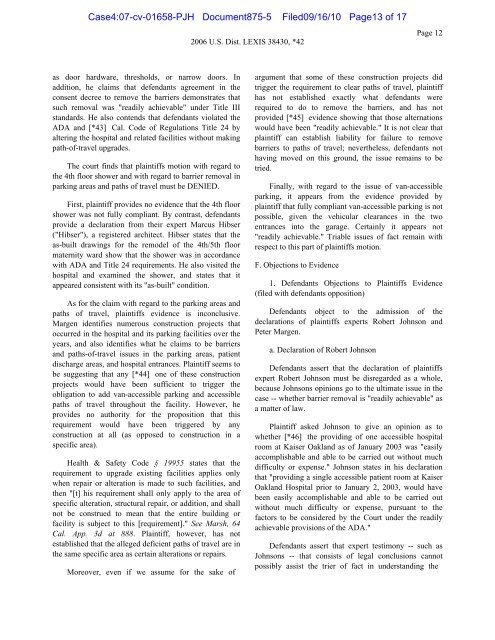exhibit 2 - SAP Lawsuit Portal
exhibit 2 - SAP Lawsuit Portal
exhibit 2 - SAP Lawsuit Portal
Create successful ePaper yourself
Turn your PDF publications into a flip-book with our unique Google optimized e-Paper software.
Case4:07-cv-01658-PJH Document875-5 Filed09/16/10 Page13 of 17<br />
as door hardware, thresholds, or narrow doors. In<br />
addition, he claims that defendants agreement in the<br />
consent decree to remove the barriers demonstrates that<br />
such removal was "readily achievable" under Title III<br />
standards. He also contends that defendants violated the<br />
ADA and [*43] Cal. Code of Regulations Title 24 by<br />
altering the hospital and related facilities without making<br />
path-of-travel upgrades.<br />
The court finds that plaintiffs motion with regard to<br />
the 4th floor shower and with regard to barrier removal in<br />
parking areas and paths of travel must be DENIED.<br />
First, plaintiff provides no evidence that the 4th floor<br />
shower was not fully compliant. By contrast, defendants<br />
provide a declaration from their expert Marcus Hibser<br />
("Hibser"), a registered architect. Hibser states that the<br />
as-built drawings for the remodel of the 4th/5th floor<br />
maternity ward show that the shower was in accordance<br />
with ADA and Title 24 requirements. He also visited the<br />
hospital and examined the shower, and states that it<br />
appeared consistent with its "as-built" condition.<br />
As for the claim with regard to the parking areas and<br />
paths of travel, plaintiffs evidence is inconclusive.<br />
Margen identifies numerous construction projects that<br />
occurred in the hospital and its parking facilities over the<br />
years, and also identifies what he claims to be barriers<br />
and paths-of-travel issues in the parking areas, patient<br />
discharge areas, and hospital entrances. Plaintiff seems to<br />
be suggesting that any [*44] one of these construction<br />
projects would have been sufficient to trigger the<br />
obligation to add van-accessible parking and accessible<br />
paths of travel throughout the facility. However, he<br />
provides no authority for the proposition that this<br />
requirement would have been triggered by any<br />
construction at all (as opposed to construction in a<br />
specific area).<br />
Health & Safety Code § 19955 states that the<br />
requirement to upgrade existing facilities applies only<br />
when repair or alteration is made to such facilities, and<br />
then "[t] his requirement shall only apply to the area of<br />
specific alteration, structural repair, or addition, and shall<br />
not be construed to mean that the entire building or<br />
facility is subject to this [requirement]." See Marsh, 64<br />
Cal. App. 3d at 888. Plaintiff, however, has not<br />
established that the alleged deficient paths of travel are in<br />
the same specific area as certain alterations or repairs.<br />
Moreover, even if we assume for the sake of<br />
2006 U.S. Dist. LEXIS 38430, *42<br />
argument that some of these construction projects did<br />
trigger the requirement to clear paths of travel, plaintiff<br />
has not established exactly what defendants were<br />
required to do to remove the barriers, and has not<br />
provided [*45] evidence showing that those alternations<br />
would have been "readily achievable." It is not clear that<br />
plaintiff can establish liability for failure to remove<br />
barriers to paths of travel; nevertheless, defendants not<br />
having moved on this ground, the issue remains to be<br />
tried.<br />
Finally, with regard to the issue of van-accessible<br />
parking, it appears from the evidence provided by<br />
plaintiff that fully compliant van-accessible parking is not<br />
possible, given the vehicular clearances in the two<br />
entrances into the garage. Certainly it appears not<br />
"readily achievable." Triable issues of fact remain with<br />
respect to this part of plaintiffs motion.<br />
F. Objections to Evidence<br />
1. Defendants Objections to Plaintiffs Evidence<br />
(filed with defendants opposition)<br />
Defendants object to the admission of the<br />
declarations of plaintiffs experts Robert Johnson and<br />
Peter Margen.<br />
a. Declaration of Robert Johnson<br />
Page 12<br />
Defendants assert that the declaration of plaintiffs<br />
expert Robert Johnson must be disregarded as a whole,<br />
because Johnsons opinions go to the ultimate issue in the<br />
case -- whether barrier removal is "readily achievable" as<br />
a matter of law.<br />
Plaintiff asked Johnson to give an opinion as to<br />
whether [*46] the providing of one accessible hospital<br />
room at Kaiser Oakland as of January 2003 was "easily<br />
accomplishable and able to be carried out without much<br />
difficulty or expense." Johnson states in his declaration<br />
that "providing a single accessible patient room at Kaiser<br />
Oakland Hospital prior to January 2, 2003, would have<br />
been easily accomplishable and able to be carried out<br />
without much difficulty or expense, pursuant to the<br />
factors to be considered by the Court under the readily<br />
achievable provisions of the ADA."<br />
Defendants assert that expert testimony -- such as<br />
Johnsons -- that consists of legal conclusions cannot<br />
possibly assist the trier of fact in understanding the


